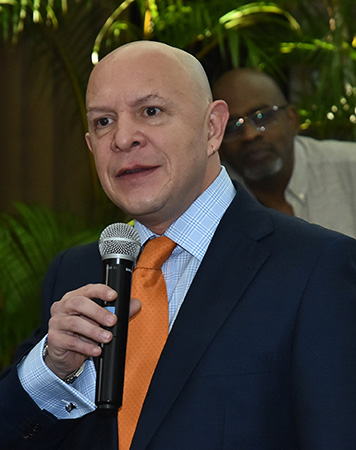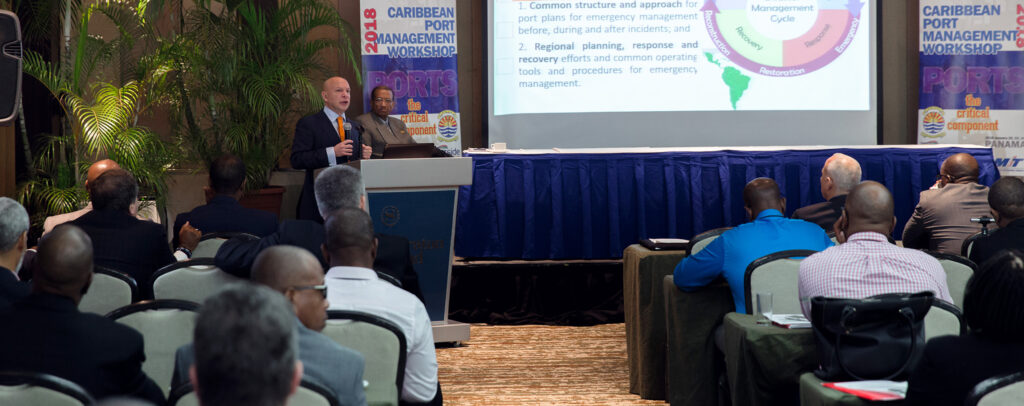CIP building capacity for risk management, assessment
2018, June 1: It is vital that the Caribbean consider the many risks that could impact its ports and develop sound plans to combat these risks. A means of cascading response capabilities from neighbouring countries throughout the Caribbean must be found.
It was in this context that the Secretary of the Organization of American States’ Inter-American Committee on Ports (CIP), Jorge Durán outlined the OAS organization’s regional programme for Capacity Building in Port Logistics for Disaster Risk Management to the inaugural Caribbean Port Management Workshop. The 3-day event was held in Panama City on January 22, 23 and 24, 2018.

The CIP executive told the more than 70 participants from across the Caribbean region that the main objective is to provide training to port authorities in Small Island Developing States (SIDS) in the Caribbean and to prepare and administer humanitarian assistance, equipment and supplies before, during and after disasters and complex emergencies.
Manmade and natural hazards pose a high risk to the operation of ports all around the Americas. However, in Caribbean SIDS, national economies depend heavily on trade, ample justification for the programme. Ports in SIDS in the Caribbean are critical to the management of international humanitarian assistance in cases of disasters, he emphasised.
Components
He outlined five components of the Capacity Building in Port Logistics for Disaster Risk Management programme:
- Assessment (risk and capabilities): A comprehensive review of both the manmade and natural hazards that have the potential to threaten or disrupt Caribbean.
- Emergency Response Plan Prototype: Development of a prototype Emergency Response Plan for a Caribbean Port to address the risks posed by natural and manmade hazards to ports.
- Training: Training represents the bulk of the project. It will include workshops and seminars, delivered in cooperation with Strategic Partners
- Regional simulations and drills: Design, facilitation and evaluation of emergency response drills, exercises and simulations with the participation of ports authorities.
- Model legislation, regulation and procedures: Look into international agreements and instruments to complete their own emergency response plan based on the prototype provided in component 2.
The programme is regional in scope and is predicated on region-wide Inter-Agency Coordination including the Port Management Association of the Caribbean. Anticipated outcomes include: (a) a common structure and approach for port plans for emergency management before, during and after incidents; and; (b) the launch of regional planning, response and recovery efforts as well as establishment of common operating tools and procedures for emergency management.

Deliverables
Mr. Duran identified six deliverables of the programme:
- Risk assessment developed;
- Training and capacity building delivered on:
(i) Disaster /emergency readiness –disaster preparedness, including national/port emergency response plan identifying inter-agency coordination needs;
(ii) Humanitarian supply and equipment management –including classification, labeling, storage and distribution;
(iii) Humanitarian supply disposal post-disaster –including expired medicines, food and food containers; and,
(iv) Model legislation and procedures;
- Emergency response drills, exercises and simulations designed and delivered;
- Model or prototype developed for: emergency response plan; custom laws; and, regulations with disaster risk management considerations;
- Training and capacity building delivered in the implementation of international conventions, instruments and agreements, soft and hard law related to emergency management and readiness, customs and immigration; and,
- A Directory of experts with expertise profile (integrated into the Inter-American Network for Disaster Mitigation (INDM)).
Communication system
The CIP executive said that, as a first step to establishing a communication system, funding would be sought to establish a restricted site, where members of the Framework can exchange information in a secure manner.
He said that, in collaboration with HudsonAnalytix, a project proposal for the establishment of a reliable and secure direct communication system has been developed, offering a range of internationally recognized training programmes. []
[See below OAS-CIP document: Planned Initiatives in the Caribbean for 2017-2018]
__________________
INTER-AMERICAN COMMITTEE ON PORTS
PLANNED INITIATIVES IN THE CARIBBEAN FOR 2017-2018
Capacity Building in Port Logistics for Disaster Risk Management. (Development stage)
*(Component of the Natural Disaster Response initiative)
Objective: The Project is expected to significantly improve pre and post emergency / disaster management readiness and logistic capabilities in the Caribbean Basin.
- Justification: For Caribbean ports the risks posed by man-made incidents and natural disasters occur regularly, not only affecting port operations, but with severe economic and social consequences. In addition, many of the Caribbean nations have yet to ratify a variety of International Protocols designed for international and regional cooperation and assistance, including during emergency events. Given the lack of participation in formal conventions intended to support regional emergency management efforts, it is vital for Caribbean nations to have the capabilities to fully understand both the range and complexity of the scenarios they face, their impact on businesses, commerce and operations and, significantly, their ability to draft national emergency response plans and efficient logistics management before and after a disaster. Each port should have a well-developed inter-agency emergency response readiness plan to address all risks and hazards that could jeopardize the port or the port operations. Response readiness consists of the preparation and exercising of contingency plans; the identification and training of a response management team, and the procurement and presaging of capable response resources, or provisions to obtain such resources on short notice
Expected Results:
- First, the project will provide training and exercises for the Caribbean port authorities and other pertinent agencies at the decision and policy maker level that will include the ability to draft and execute their own inter-agency emergency/disaster response readiness plan.
- Second, more hands-on, level of training will be such that emergency response personnel understand international best practices and standards for effective emergency and/or disaster mitigation management. The training will also provide international best practices for organizing and responding to emergency events. Role training for each of the positions on the emergency response team, as well as overall team training, will be provided.
- Third, will provide training and capacity building for efficient logistic operations to efficiently manage logistics of resources, equipment, disaster relief and humanitarian assistance received by other countries and agencies both before and after the disaster strikes. It will also provide training and address the rise of sea levels in coming years.
- Fourth, Member States will be in a better position to take action so as to develop legislation, regulations, manuals, protocols and procedures for the management of the logistics for facilitation of response resources, disaster relief and humanitarian assistance, which will facilitate local efforts while improving regional readiness.
Connecting Ports in the Caribbean for Enhanced Maritime Security and Operations (Development stage)
- Objective: This project is intended to create an efficient, secure, real-time, online communication platform for Port Security Officers and other security officials to improve communication, coordination, and cooperation for enhanced port and maritime security. The Platform will enable sharing of real-time or near-real-time information regarding vessels moving among participants’ ports, including notices of arrival, crew lists, cargo information, and incidents or issues of concern
- Justification: With 90% of world trade facilitated via the maritime industry, ports face a never-ending challenge of effectively screening merchandise and goods. Port stakeholders must be able to more rapidly collect, analyze and rapidly share data in a proactive and secure manner with their peers in other countries and ports regarding ships, cargo, and potential security threats, and/or threatening activities. The agencies responsible for port security in the Region … indeed in the Hemisphere … are unable to communicate with one another in either an efficient or secure manner. As a challenge experienced elsewhere, recent experience has identified a lack of specific and effective communication capabilities and related processes that should be considered for adoption in the Caribbean. Since the Caribbean Basin itself serves as the essential nexus of Western Hemisphere trade – even more so now with the expanded Panama Canal – implementing this capability will strengthen the security response capabilities of Caribbean regional stakeholders.
During the CIP’s First Workshop on Maritime Safety in 2014, Barbados identified the need to create a regional Caribbean framework Port Security Officials to address this issue. At the time, Port Authorities of 17 OAS Member Countries supported this proposal. During the X Regular Meeting of the CIP held in Montevideo Uruguay on July 29, 2016 (CIDI/CIP/RES. 1 (X-O/16), CIP Member States unanimously approved this initiative and instructed the Secretariat to work on the creation of a communication platform.
Expected Results.
This project will:
- Contribute to improved connectivity and increased security in the Caribbean Basin region.
- Improve institutional and human capacities to support of national security agencies to provide greater regional collaboration and inter-connectivity across borders and throughout the region through training and capacity-building for the implementation and use of the communication network in the Caribbean.
- Increase operational security requirements in the Caribbean
- Create a network of PFSO for sharing of real-time information regarding security incidents or response operations.
Caribbean Risk (CRISK): Risk Assessment of Potentially-Polluting Shipwrecks in the Caribbean Basin (Development stage)
- Objective: This project will contribute to the continued socio-economic growth of the Caribbean Basin OAS Member States through the protection and preservation of the marine environment and its ecological diversity.
- Justification: Caribbean waters and coastlines are threatened by potential oil and chemical spills from hundreds of large shipwrecks – many of which sank during WWII. These corroding vessels may begin chronically leaking or release large amounts of oil at any time, damaging many miles of tourist beaches, mangroves, wildlife, and fisheries, and costing millions or billions of dollars in cleanup and damages.
There are an estimated 450 wrecks of large vessels (averaging 5,800 GRT), 300 of which may be of concern and which should be investigated further. The wrecks are spread through the region with many close to sensitive shorelines. Over 90% are over 50 years old. The wrecks may contain as much as 1.2 million cubic meters (318 million gallons) of oil, and possibly other hazardous materials. These older wrecks are particularly problematic for two reasons: the wrecks are more likely to be experiencing significant corrosion; and the fuel oils and other hazardous materials on board are likely to be particularly toxic (including significant heavy metals) due to the composition of fuels used during that era.
Expected Results:
- The project will systematically assess approximately 300 large shipwrecks in the Caribbean Sea to identify the 100 most at risk with respect to the probability of oil or chemical leakage that may constitute a threat to the ecological stability and socioeconomic resources of the region, particularly in the tourist industry.
- The project will provide the OAS Caribbean Member states with vital information to conduct cost-benefit analyses and to develop effective mitigation strategies – from periodic monitoring to investigative surveying to pro-active salvage operations to safely remove contaminants.
- The information will also allow coastal authorities to track potential sources of “mystery spills” oiling beaches and injuring wildlife.
- Member States will be in a better position to take action so as to help prevent damages to the ecological and socioeconomic resources of the region. []





